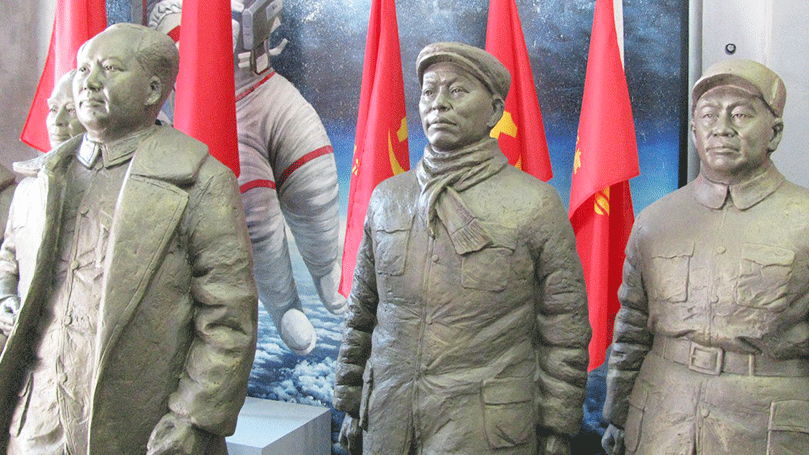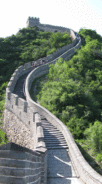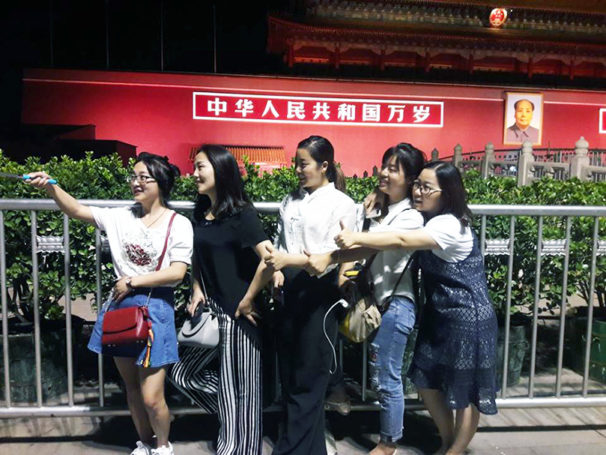
China is huge and diverse country with a long complex history undergoing enormous changes in a short span of time. Just a bit of context: The people’s revolution took place in 1949 with the declared aim to build socialism.

The initial model was patterned after the Soviet Union’s centralized economy – total public ownership and wage leveling and collectivization of agriculture.
But it was largely a failure and a new path of development was charted beginning in 1978 that went against Marxist orthodoxy. The reforms ushered in the socialist market economy and “opening up” to the global economy. It was turned out to be a turning point.
China saw no other way to overcome its overwhelmingly agricultural economy. The reforms allowed China to accumulate capital by introducing a mixed economy and becoming a low-wage manufacturing zone for the capitalist world.
The first reforms were carried out in the agricultural sector after 18 courageous farmers in the village of Xiaogang signed a secret pact to split up communal lands with earnings distributed to each farmer based on what they produced.
The farmers thought they would be persecuted but became national heroes instead. Production increased dramatically. The reforms were extended to the entire agricultural and then manufacturing and service sectors.
The changes since 1978 are unprecedented in human history. China has leapt from underdevelopment to a middle economy with a modern infrastructure.
Within a decade China will be world’s largest economy as measured by GDP.
Seven hundred million people have been lifted from extreme poverty
Seven hundred million people have been lifted from extreme poverty – defined by the World Bank as, $1.90 per day – which will be eliminated completely in three to five years. Let that sink in. Most Chinese will live a “moderately prosperous life” by 2020.
Economic growth is nearly 7 percent per year, and China accounts for 30 percent of global economic growth. The country poured more concrete from 2011 to 2013 than the U.S. did in entire 20th century.

Wages, while still low by U.S. standards, have risen by 64 percent since 2011 and are now on par with Portugal and South Africa.
The public health care system, which is funded through employee, employer and local government contributions, covers 97 percent of residents with basic service, however there are many gaps, shortages and corruption. Private health care is growing and quality care can be purchased for a price.
The reforms ended total state ownership of the economy and strict central planning. Roughly 60 percent of fixed investment is still publicly owned or controlled.
The government directs social investment in education, healthcare, housing (of which there are still great shortages and high costs) and transit. It also controls armaments, energy production, oil and petrochemicals, telecommunications, coal, aviation, and shipping.
However, the breakneck pace of development came at a tremendous cost including subsuming worker rights to overall development, growth of a capitalist class, (the source of most corruption), economic inequalities, urban and rural disparities, and severe environmental problems.
China is in the primary stage of socialist construction
According to President Xi Jinping, China is the world’s largest developing country but still in the primary stage of socialist construction. It is attempting to overcome a contradiction between imbalanced growth and rapidly growing expectations and needs of the people.
China has entered a new stage of development. It is carrying out bold new economic, social, and governance reforms extending decades into the future.
These are steps toward building what the Chinese call a “modern, democratic, culturally advanced, harmonious, and sustainable socialism” by 2050.
They include “Made in China 2025” a ten-year program to make China a global high-tech manufacturing power and radically increase productivity (which is approximately one-third that of the U.S. economy) through innovation and cutting-edge digital technology, and artificial intelligence.

Until now, China has competed with other developing countries to produce consumer goods for advanced capitalist economies. In the future, new industries will satisfy the rapidly growing domestic market and then compete in the advanced manufacturing and technological sectors of the global economy.
To achieve this, China must create a world-class system of universities, research institutions, and hospitals to attract world-class scientific talent.
Mind boggling projects are underway to modernize its infrastructure and relocate 250 million people into mega cities, tunnel systems under the ocean, new million-person cities built from scratch, and a 35,000-kilometer-high speed rail system.
The economic reforms depend on China opening ‘wider” to the global economy and so Trump’s economic nationalism is a direct threat to development.
Trump’s trade war is part of a strategic approach to undercut China
Trump’s trade war is part of a strategic approach to undercut China as an economic rival and force it to abandon its socialist-oriented development, something China will never do.
The strategy includes Cold War-like containment by building a white nationalist Christian alliance stretching from the U.S. to Russia. The aim is to preserve global domination of white-nationalist dominated states, a racist strategic concept pushed by Steve Bannon. Trump accusations that China is engaged in election interference is an attempt to whip up anti-China hate.
With a string of military bases, U.S. imperialism wants the ability to block China’s access to Pacific trade routes in case of a conflict. China is challenging this threat by diversifying trade routes and building a military presence in the South China Sea. This has led to disputes with its neighbors including Vietnam. While tensions remain, Vietnam and China are seeking to resolve their differences diplomatically.
With the collapse of socialism in the USSR, the U.S. emerged as the world’s sole economic and military superpower and sought to preempt future rivalries by integrating Russia and China into the global capitalist trade system.
It continued its Cold War-like foreign policy by expanding NATO eastward and militarily encircling Russia and China.
But changes in Russia and China, mounting crises and strategic military blunders have shaken the global capitalist world.
The neoliberal globalization of the 1980s-90s was characterized by deregulation, privatization, deindustrialization, dropping of tariff barriers and a “race to the bottom”.
China believes the world is entering a fourth stage of globalization
China believes the world is entering a fourth stage of globalization, a process that has unfolded over 400 years, one marked by multipolarity, shared development and cooperation. The geographical center of globalization is shifting to Asia and the emerging economies.
China and emerging economies are ascending and US and western imperialism are declining. Whether this happens peacefully is up to current and future U.S. administrations.
Globalization will increasingly be dominated by a new set of actors, and the goal for each country in this new era should be to improve people’s lives instead of facilitating a race to the bottom, rebuilding domestic manufacturing, and modernizing infrastructure instead of scapegoating other countries. There’s plenty of work and wealth to go around (especially with climate change and adaptation to its imperatives).
China’s growing economic role means a larger diplomatic role, including with the Iran Nuclear Deal, Paris Climate Agreement and defusing tensions between the U.S. and North Korea.
China is promoting a new governing concept called “building a community for a shared future for humankind.” The concept is based on multilateralism, fairness and justice in the global economy, mutual benefit, and win-win economic cooperation.
It calls for:
• Working out disputes through dialog;
• Non-involvement in the internal affairs of other countries, and no Cold War type economic and military alliances;
• Collective security;
• Sustainable development;
• Cooperation to solve problems of development, climate change, peace, poverty, disease, resource allocation, or security;
• Relations based on state-to-state relations and partnerships;
• Restructuring the international order, and reforming global governance and financial systems established after WWII such as the United Nations, IMF and World Bank.
China has built alternative international networks and relationships including the Shanghai Cooperative Organization (SCO), BRICS (the association of five major emerging economies: Brazil, Russia, India, China and South Africa).
China’s most ambitious project is the Belt and Road Initiative
By far China’s most ambitious project is the Belt and Road Initiative (BRI) launched in 2013. It is a massive $1 trillion development project comprising over 2,000 local construction projects. It could boost global economic development by 12 percent.

Once complete, 71 countries in Asia, Africa, and Europe, including some of the poorest, will be linked via six land and sea corridors featuring modern infrastructure, rail and road transport, modern ports, electric grids, refining capacity, water sanitation, pipelines, and cultural exchanges.
The BRI is also a strategic plan to bypass any future threat of an U.S. economic blockade.
To help fund the BRI, China is developing alternative financial institutions which threaten to upend the international financial order.
China has been accused of using the BRI to set debt traps and exploit developing countries like other colonial powers.
However, I believe the loan terms are like IMF loans without the strings attached including imposition of austerity policies. And even where countries go into debt, or transfer infrastructure projects to the Chinese as collateral, the long-term agreement is to wipe those debts out and to return the infrastructure.
Ecological civilization
Another reform centers on shifting to a sustainable path of development to build what China calls an “ecological civilization.”
This is a response to environmental destruction from industrialization, the growth of a widespread environmental movement and the goal for people to live a healthy life. And China can’t achieve its development goals relying on fossil fuel consumption.
China is the world’s biggest investor in renewable energy and will spend between $6 and $20 trillion to go green, funding it with an environmental tax. By 2050, 60 percent of energy and 90 percent of electricity will be from renewables.
Construction of 150 coal fired plants has halted, and filters are being installed on the remaining plants.
China sells more electric vehicles than Europe and the U.S. combined and passed laws to create a circular economy (reuse, recycling and remanufacturing).
Nearly 300 eco-cities are being built and even present day cities are being transitioned to insure sustainability.
China is carrying out the largest reforestation project in the world.
A few years ago, Beijing was plagued with regular sandstorms originating in Inner Mongolia. Planting a “Great Green Wall” has largely contained the sandstorms.
Enormous challenges remain. China still produces more CO2 than any country, and plastic is ubiquitous and a major source of the Great Pacific Garbage Patch. (Although as of 2018 China will no longer import plastic waste from the U.S. and E.U.).d
Let’s hope for humanity’s future they succeed.
An ongoing struggle for democracy
I want to end with a few words on democratic reforms.
China’s experience with building working-class democracy and democratic institutions is obviously different from our experience and those of other capitalist countries.
China is in the primary stage of socialism and remains a developing country. I interpret this to mean building the material basis, an essential precondition to achieving a “people centered society,” and democratic institutions, civil society and political culture.
China is an evolving socialist democracy and the Communist Party freely admits to imperfections and shortcomings. But to understand the challenges you must take into consideration the following:
2000 years of imperial rule ended in 1912 with the Xinhai Revolution followed by civil war, Japanese occupation and WWII; the revolutionary war for independence resulted in the founding of the People’s Republic in 1949 only to be followed by the turmoil of the “Great Leap Forward” and “Cultural Revolution.”
China didn’t pass through a capitalist democratic republic phase. During its recent history, a single party, the CPC, emerged as the leading force. The dire conditions gave rise to authoritarian tendencies which carried over from the revolutionary war for independence and establishment of a socialist republic.

Besides extending basic rights to education, health care, affordable housing, transit and a clean environment to everyone, there is the issue of developing organs of people’s government that allow greater participation, decision-making and management.
In my estimation, creating democratic institutions didn’t really begin until the reforms of 1978 and even then, many things were subsumed to developmental tasks.
China’s system of elections is hierarchical – each legislative body is drawn from the legislative bodies below. Itws system of participatory and multi-party consultative democracy, including with the trade union movement, is unique.
National, state and local direct elections are the goal, which of course will be free from the influence of corporate money.
The CPC is projecting other governance reforms that expand grassroots participation and decision-making.
Emphasis is being placed on establishing a rule of law society that enforces the constitution, a judicial system and legal rights, and consumer and environmental protections.
It includes reforms of the Party, the driving force behind everything, that strengthen its role and reinvigorates Marxism as a revolutionary methodology. As Xi says, “The Party too must change with the times.”
Personally, I can’t see not allowing a multi-party electoral system, because there are a variety of class and social forces already in existence (although the Chinese have a system of multi-party consultation).
Although an independent media has emerged since the late party leader Deng Xiaoping led the PRC, Reporters without Borders ranks press freedom very low. There is a widespread domestic social media, but Facebook, Twitter, and YouTube are banned.
The free flow of information in a world of cyber warfare and mass disinformation is a challenge facing every country. We can attest to that given foreign interference in the 2016 elections. But this encourages resentment and Chinese citizens are discovering ways around censorship. I think they will have to create a culture that allows for the free exchange and battle of ideas.
Women in the socialist giant are guaranteed equal rights under the constitution but to be practiced effectively by society is far more difficult as we know. Over 80 percent of women are employed oodin the workforce but vestiges of a deeply patriarchal past remain including widespread domestic abuse, sexual harassment, property rights and unwanted daughters.
The presence of women in CPC leadership and among elected officials is still scarce.
Changes are afoot including with a new anti-sexual harassment law and women now make up half of all university students.
Gay and lesbian rights also lag. I was told by a young gay journalist attitudes toward gays and lesbians are like the U.S. military’s “Don’t ask, don’t tell” policy. But among China’s younger generation there is a broad acceptance of LGBTQ rights.
It will likely take transformative social equality movements like our #MeToo and marriage equality movements to completely change attitudes, and practices. These movements, many built through the social media, are present in labor, the environment and among women.
Finally, with respect to national minorities there are 56 ethnic groups in China with the Han making up 91 percent of the population. There have been recent press accounts about mass detention of 1 million Yugurs, who are largely Muslim.
Of course, I have no way of independently verifying this but I am a little skeptical of anything the NY Times says about a socialist country.
There is heightened security in this province which has experienced a separatist movement that has carried out terrorist acts. From what I understand there is concern about Yugur fighters who joined with ISIS fighters.
There are other provinces with large Muslim populations that are not experiencing the same heightened security.
One thing China will never allow is the splitting up of their country along sectarian lines. We’ll have to await the investigation from some independent media sources.
I’ve gone on too long. That’s a snapshot through my lens. It’s just scratching the surface and I hope you have an opportunity to see for yourself and draw your own conclusions.
Images by John Bachtell.


 Join Now
Join Now